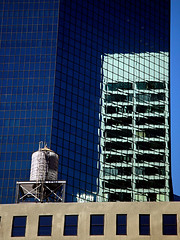Roof Water Harvesting - Is it Practical? by David Reynold
Many of the pollutants in urban runoff are biodegradable, and will not do as much harm to the environment if allowed to break down. Catching roof water runoff in rain barrels is a way to save water and help the environment at the same time.
The main problem with this practice is that water from a roof has lots of nasty stuff in it including harmful bacteria, dissolved dust, and any pollutants that are in the air around the roof; in addition to any substances in the roofing material or on the roof that are water soluble.
With the exception of cedar shake roofs, or roofing material that contains asbestos or moss killer, most roofing material is suitable for supplying irrigation water for vegetable gardens if proper filtering is used. Some roofing material such as metal roofing with a non-toxic baked on enamel finish, will provide water that can be used for consumption providing proper filtering and testing procedures are used. Many people in places outside of the U.S. (and some in the U.S.) use roof water harvesting for their water supply with no problems.
A practical water filtering system that will make most roof water runoff usable consists of a "first flush diverter", followed by a slow sand water filter (often called a biological sand filter, or a biosand filter) where the water in turn flows into a storage container.
A properly functioning slow sand water filter will remove up to 99.999 percent of harmful bacteria and viruses from water, along with 50 - 90 percent of industrial chemicals. It takes about 3 weeks for a biological sand filter to "mature" . The sand must be kept submerged under oxygen-rich water at all times. If the sand is exposed to air or if there is not enough oxygen in the water the filter will "die" because the organisms are aerobic (need oxygen) and aquatic.
Before the filter matures, it will not remove pathogens. A first flush diverter is a device that diverts the first "flush" of water from runoff to a separate container thereby keeping the most polluted water out of the rain barrel. Both of these devices can be built from recycled materials, (with the exception of the PVC pipe needed), by the average person.
Slow sand filters are approved by the U.S. Environmental Protection Agency, and the World Health Organization for water purification; and furthermore they are the most effective filter at removing cryptosporidium parvum cysts (beaver fever pathogens) without adding any poison chemicals to the water (cryptosporidium cysts are not sufficiently killed by chlorine or ozone when only added in safe levels) . These filters work on gravity and do not need any petroleum energy to operate. They are sustainable technology. They will last indefinitely as long as they are kept out of direct sunlight.
A slow sand filter will "purify" water provided the water is fairly clear (has low turbidity), is free of concentrated, powerful toxic chemicals, and has some non-pathogenic living organisms in it to start with. As a slow sand filter matures, it gets better and better at filtering water; however the flow rate slows down considerably. These filters work by having a biological layer of organisms (much like a pristine undisturbed wetland) in the top 20 or so centimeters of the sand.
The biological "mat" that forms filters water by inactivating, consuming, and trapping pathogens in the biological layer. Particulate matter is also trapped in this biological mat which is often called the "Schmutzdecke". The sand also works to physically filter out undesirable matter from the source water.
Tap water could be filtered by a slow sand filter but it would need organisms in it to start up. A "culture" of friendly bacteria and microorganisms must form in a slow sand filter. The filter actually contains a mini-ecosystem and the result is potable water. A somewhat similar situation purifies most of the fresh water on this earth as it flows through the ground slowly and back into the ocean. The soil is full of bacteria that destroy and break down harmful organic substances.
A slow sand filter does not completely remove "everything" from water like distilling or reverse-osmosis. Many of the minerals in the water are still there, and harmless bacteria may also be in the water. As a good measure, a UV filter probably would be a good idea if water from your slow sand filter is used for consumption, but not needed if the water is used for irrigation. If you intend to consume water from a slow sand filter, Have it tested first!
After 25 years working in industry, David is a recent graduate of the University of Washington (class of 2006) with an interdisciplinary degree in environmental science. He has been working on and studying biological sand filters for the past 2 years. A summary of the study is on the web at http://www.slowsandfilter.org
Article Source: http://EzineArticles.com/?expert=David_Reynold
http://EzineArticles.com/?Roof-Water-Harvesting---Is-it-Practical?&id=2322266
http://thezeitgeistischanging.blogspot.com/
http://psychedelichippiemusic.blogspot.com/
http://psychedelichippiefashion.blogspot.com/
http://www.soul-flower.com/Merchant2/merchant.mvc?Screen=SFNT&Store_Code=SOS&AFFIL=Robert_Muller

No comments:
Post a Comment